Baltimore Orioles Top Ten Prospects for 2017

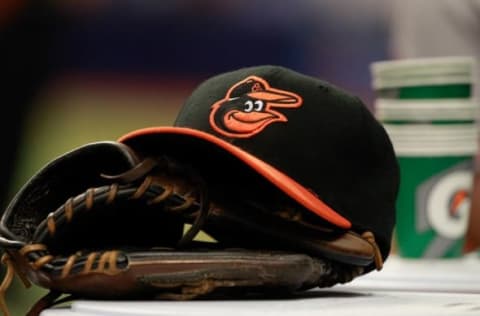
The Baltimore Orioles have had a rough reputation lately for their minor league system. Has that improved, and who are the best guys in the system now?
An Introduction
Our minor league top 10 series is coordinated by Benjamin Chase, one of our contributors at Call to the Pen.
He has pored over thousands of minor league games over the course of the year via milb.tv along with speaking with a number of team and independent scouts. These lists are based out of those conversations.
Each system will have prospects from 10 to 1, and then finish with one newcomer to the system that is worth keeping an eye on that is not in the top 10 at this time.
Conversations are certainly encouraged in the comments section on each system as we go along!
There are signs of life, but it will take more than one year to turn this around
Orioles System Review
For many years, the Orioles have been considered one of the 2-4 worst systems in the entire league. While they may not be in that rough of shape at this point, they are still a bottom 10 system for sure.
Certainly the 2016 draft was a major step for the Orioles. Three players from the draft class made the top ten, along with a newcomer as well. Beyond those four, there were a collection of players that scouts were very impressed with.
On top of that, there were a number of excellent steps forward in the system. In my minor league all-star team produced earlier this fall, I selected Yermin Mercedes as my starting catcher. Aderlin Rodriguez had a breakout year.
There are signs of life, but it will take more than one year to turn this around. Let’s take a look at this year’s top 10!
Next: #10
10. Tanner Scott, LHP
Birthdate: 7/22/94 (22 years old)
Level(s) Played in 2016: high-A, AA
Stats in 2016: 64 1/3 IP, 4.76 ERA, 1.51 WHIP, 19.93 BB%, 28.32 K%
So, there is really one reason and one reason only why Scott is on this list. When he throws his top end velocity, the number begins with a 1, and it has three digits!
Scott tops out at 101, but really, that’s what he offers at this point. Coming from the left side, that’s elite velocity that you just don’t find more than a handful of times in the entire minor leagues.
After showing solid control in 2015, the control regressed considerably in 2016. With a slider that’s fringe average and a change that is below-average, Scott really has nothing else but the fastball to work with.
After showing solid control in 2015, the control regressed considerably in 2016
The Orioles see Scott as a major weapon out of the bullpen, and if he can just get his control under wraps, he’d be an incredibly elite reliever.
With velocity like that, he will get a shot at some point, and his story will be an exceptional one to tell, getting drafted out of junior college in the 6th round, working his way through bumps and bruises and finally to his big league opportunity.
Next: #9
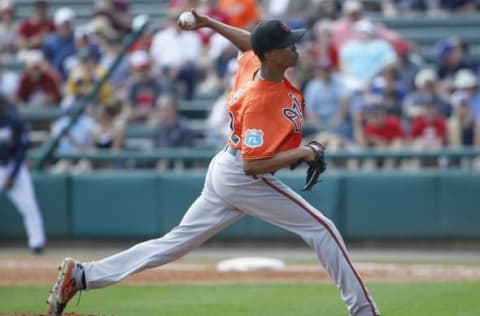
9. Chris Lee, LHP
Birthdate: 8/17/92 (24 years old)
Level(s) Played in 2016: AA
Stats in 2016: 51 1/3 IP, 2.98 ERA, 1.05 WHIP, 6.4 BB%, 9.36 K%
Lee struggled for three years in rookie ball before he finally had a breakout in 2014. The Orioles acquired him from the Astros in May of 2015 for two international bonus slots.
A long, lean lefty with arms and legs for days, Lee has big issues keeping his delivery from the left side, which has led to command issues in his pro career at times. The Orioles have worked with him to be more consistent in his delivery, but after shoulder issues in May of 2016, he slipped into old inconsistent habits.
At his best, Lee sits 91-94 with his fastball, touching 96. He has good downhill plane on the pitch with his long arms and gets some good late movement on the pitch.
He has good downhill plane on the (fastball) with his long arms and gets some good late movement on the pitch
Lee throws two variations of his slider and a change. His big issues when he is off in his delivery is in locating his off speed stuff.
Lee is quite athletic on the mound, and when healthy, his stuff was incredibly difficult for AA hitters to square up, even if he wasn’t missing many bats.
If he can get back on the mound in 2017, it’s likely he’ll get one last chance as a starter before being relegated to the bullpen due to his age.
Next: #8
8. Keegan Akin, LHP
Birthdate: 4/1/95 (21 years old)
Level(s) Played in 2016: short-season A
Stats in 2016: 26 IP, 1.04 ERA, 0.85 WHIP, 6.93 BB%, 28.71 K%
Western Michigan isn’t exactly where scouts typically go to find the hardest-throwing lefty in a class, but that’s exactly what they got in this year’s college class in Akin.
Akin sits 91-94 while touching 96-97 with his fastball, and he gets late life on the pitch that really leaves hitters flailing. He has a slider and a change, and both flash plus potential with current above-average performance.
Akin has a short, stout frame and has excellent mechanics
Akin has a short, stout frame and has excellent mechanics. He fills the zone with all three pitches, showing excellent command of the fastball. While he has good control of the slider and change, his command of both is behind the fastball.
His ability to control all three pitches with such seeming ease will allow Akin to be a starter going forward, and if he can harness the command on his off-speed stuff, he could rocket up this list!
Next: #7
7. Austin Hays, OF
Birthdate: 7/5/95 (21 years old)
Level(s) Played in 2016: short-season A
Stats in 2016: .336/.386/.514, 4 HR, 4 SB
When the Orioles selected the Jacksonville outfielder in the third round in June, immediately the word was how great a bargain they got in their selection.
Then he just went out and showed exactly that. Hays has big power from a quick swing and strong wrists. His swing is more level currently, so that power is more gap power now, but with a touch of adjustment to his swing, he has the explosive, easy swing to generate a ton of power.
Hays has big power from a quick swing and strong wrists.
Hays is an exceptional corner defender. He has a plus arm in the outfield and has good natural instincts in the outfield. He’s more average in his range, but the instincts and arm can certainly make up for it.
In his pro debut, Hays showed exactly the type of offensive profile that many were projecting when they saw him be among the league leaders in home runs at Jacksonville.
Hays comes from a smaller college, so the Orioles may let him work his way up the system.
Next: #6
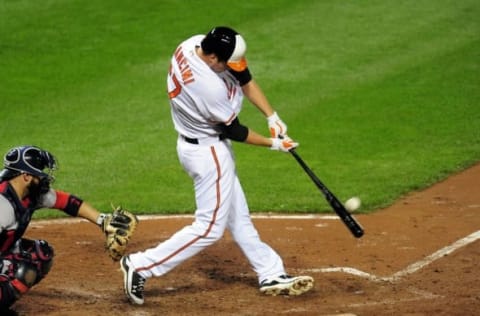
6. Trey Mancini, 1B
Birthdate: 3/18/92 (24 years old)
Level(s) Played in 2016: AA, AAA, MLB
Stats in 2016: .282/.357/.458, 20 HR (minor league only)
Mancini is a guy who has climbed his way up the system without a lot of fanfare in spite of hitting most of the way as he’s come up since being an eighth round selection out of Notre Dame.
He took that hitting to another level in 2015, and that put him on the national radar more as he won Baltimore’s Player of the Year award, nearly collecting 200 hits in a minor league season while hitting .342 on the year.
While not quite to that level, his 2016 was nothing to sneeze at, especially considering the ballparks he played at. One scout I talked with about the Orioles mentioned that guys in the upper minors should be looking at their total extra bases rather than home runs because the upper level parks suppress home runs so severely. Many guys find it actually easier to hit balls out in hitter-friendly Camden Yards than in their final two minor league stops!
Should he open the season with the Orioles, fantasy owners should absolutely take note
Mancini was no exception to that, as he knocked out 3 home runs over 5 games with Baltimore in a short late-season trial.
Mancini has massive size at 6’4″ and 220ish pounds, but he still has enough athleticism to move once he gets going, allowing him to pick up 5 triples on the season. With that athleticism, it’s been considered that Mancini could factor in a hybrid 1B/corner outfield position with the big league club if Mark Trumbo was to leave the Orioles.
Should he open the season with the Orioles, fantasy owners should absolutely take note as Mancini is a guy who should give a good average, even if the home runs don’t come at quite the pace they did in his short stint in 2016.
Next: #5
5. Ryan Mountcastle, SS
Birthdate: 2/18/97 (19 years old)
Level(s) Played in 2016: low-A
Stats in 2016: .281/.319/.426, 10 HR
Typically only the uber-elite high school players debut in full-season ball in their first full year in the big leagues, yet Mountcastle did just that after being the last pick of the first round in 2015.
That jump to the South Atlantic League certainly didn’t phase his bat, which was where his highest grades all were coming into the season. He’s got a solid swing with good raw power, though he can fall in love with the power at times, leading to some swing and miss.
Mountcastle’s got a solid swing with good raw power
The big question on Mountcastle coming out of high school in Florida was how his defense would age. So far, it’s definitely aged well. He’s shown excellent hands and good range in the field.
In watching Mountcastle this season, I was reminded heavily of a recent shortstop for the Orioles, J.J. Hardy. He’s not got Hardy’s arm, but the smooth footwork and solid hands are very similar.
Mountcastle is 6’3″ and roughly 200 pounds currently, but his build is such that he could stay at shortstop for at least another five years as long as he keeps up with his conditioning.
With the solid bat skills and improving defense, Mountcastle may not be an uber-elite national prospect, but he’s got the chance to turn into one if he can put everything together.
Next: #4
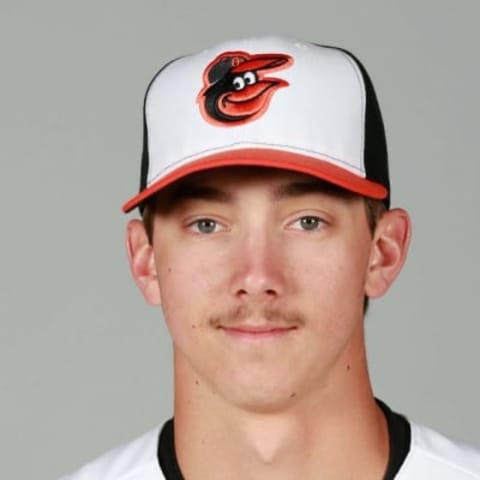
4. Hunter Harvey, RHP
Birthdate: 12/9/94 (21 years old)
Level(s) Played in 2016: rookie, short-season A
Stats in 2016: 12 2/3 IP, 2.13 ERA, 1.42 WHIP, 10.91 BB%, 32.73 K%
Marlins fans would know Harvey’s father Bryan Harvey well, as he is still tied for the second most saves in a single season in the organization, one of the first “stars” for the early Marlins franchise. He was the Marlins first All-Star representative in 1993, though, sadly, that would be his last year of arm health, and he was out of the game at 32.
Orioles fans may wonder if the injury bug is genetic for Hunter, as he’s been fighting elbow issues for most of the last two seasons, missing all of 2015 with an elbow strain before succumbing to elbow discomfort after just 5 rehab starts in 2016. It was then revealed that Harvey would need Tommy John surgery, meaning we’ll not see him until 2018 most likely.
When healthy, Harvey’s plus fastball and plus curve ball allow him to dominate hitters
When healthy, Harvey’s plus fastball and plus curve ball allow him to dominate hitters, even when his above average change up isn’t on its best day.
Harvey is only 21, so when he returns in 2018, he’ll be just 23, but without pitching above A-ball, he may end up converted to relief at that time.
The pitches are brilliant enough to place him here at this point until he’s healthy for sure. With full health, Harvey would have a very good argument at the top of this list.
Next: #3
3. Jomar Reyes, 3B
Birthdate: 2/20/97 (19 years old)
Level(s) Played in 2016: high-A
Stats in 2016: .228/.271/.336, 10 HR
As I contacted folks on Reyes, I kept hearing the same comment in some way or another – this kid is more than what the stat line will make you believe.
So I watched a number more games, and I can see what others were talking about. Reyes leaps off the screen when watching his team with his massive size. However, with that massive size, he generates a very natural swing from the right side, with pitch recognition being his biggest bugaboo.
While I had a number of people mention his below-average running and the challenge that could present at third, from watching Reyes he does have quite soft hands and good first instincts that could allow him to work his way to the majors at the hot corner. I do think he’ll end up likely at first base as he wouldn’t have the speed to man a corner outfield spot, even though his above-average arm would allow for success there.
Reyes has been pushed rather aggressively by the Orioles to this point. He spent all of 2016 as a teenager at high-A, and he’ll likely only be 20 and playing at AA in 2017. He’s at the point where it’s likely wise for the Orioles to let him grow into the upper levels and not push him before he’s ready.
There’s massive power here that is rare not just in the Orioles system, but at such a level that it is rare in the game, so there is plenty to dream on with Reyes.
Next: #2
2. Cody Sedlock, RHP
Birthdate: 6/19/95 (21 years old)
Level(s) Played in 2016: short-season A
Stats in 2016: 27 IP, 3.00 ERA, 1.07 WHIP, 11.4 BB%, 21.93 K%
Sedlock followed the path of fellow Illini hurler Tyler Jay in the path from the Illinois bullpen to a highly desired draft prospect, though he did spend one season as an elite starter first in college.
Sedlock’s fastball is his primary tool, and his slider is more developed than his other offerings, which is not surprising due to his time as a reliever.
The fastball sits in the low 90s, but was routinely touching 96-97 from the bullpen. He has excellent sink on the fastball and generates a ton of weak contact with the pitch.
Sedlock is quite athletic in his 6’3″, 200-ish frame, and he works with a very minimal effort in his delivery. His consistency of his delivery allows for hope for future control.
He has an excellent curve when he stays on top of it, but his change is still a work in progress. With the three pitches, that’s a solid starting mix. If he can work the change as well, that would give him a solid four-pitch mix.
Sedlock was held back some by the Orioles after a big workload for Illinois in his collegiate season, but he should advance quickly, possibly seeing the upper minors in 2017.
Next: #1
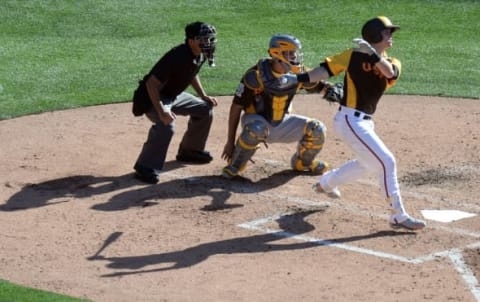
1. Chance Sisco, C
Birthdate: 2/24/95 (21 years old)
Level(s) Played in 2016: AA/AAA
Stats in 2016: .317/.403/.430, 6 HR
The one player in the system even currently in consideration for the top 100, Sisco has really jumped forward this season. Coming into the year, Baseball Prospectus had Sisco as their #101 prospect in the game.
He is one of the rare high school catchers that has made steady progress since being drafted in the second round in 2013. Typically most catchers progress in fits and starts, so a linear progression like Sisco’s is rare to see.
If you take a look at MLB Pipeline’s grades each season as he’s progressed in the minor leagues, two notable numbers have continually been increased over his career – his hit tool grade, and his fielding grade.
Once considered to be a good hitter who would have to move off of the position, Sisco’s defense has improved to the point where he’s now considered a definite regular at the catcher position.
The hit tool is most important in his future as he’s not a guy who is blessed with massive power or speed, but common grades have Sisco between a 55 and 65 hit tool on the 20-80 scale. That’s a .285-.300 hitter fairly consistently, and a hit tool like that will allow for other things to play up, like his natural gap power.
Sisco got four games in at the AAA level in 2016, so it’d not be surprising if the team sent him back there to start 2017, but with Matt Wieters leaving in free agency, this may be Sisco’s job in Baltimore for better or worse!
Next: Newcomer to Watch
Newcomer to Keep an Eye On: Matthias Dietz, RHP
Birthdate: 9/20/95 (21 years old)
Level(s) Played in 2016: short-season A
Stats in 2016: 18 2/3 IP, 4.82 ERA, 1.71 WHIP, 12.2 BB%, 9.76 K%
Dietz was the top junior college player in the 2016 draft after he added about 10 pounds of brawn to his 6’6″ frame. He now stands with a solid 225 pounds on his frame and with a fastball reaching the upper 90s.
More from Call to the Pen
- Philadelphia Phillies, ready for a stretch run, bomb St. Louis Cardinals
- Philadelphia Phillies: The 4 players on the franchise’s Mount Rushmore
- Boston Red Sox fans should be upset over Mookie Betts’ comment
- Analyzing the Boston Red Sox trade for Dave Henderson and Spike Owen
- 2023 MLB postseason likely to have a strange look without Yankees, Red Sox, Cardinals
Dietz’s slider got sharper with his added strength and his change added more movement as well. His biggest issue is missing bats with pitches as he will get many weak swings from hitters, but no miss a ton of bats. That is not a major issue as long as he’s not putting extra runners on base, but in his pro debut he did allow those extra runners, and it bit him in the end.
At Dietz’s size, he’ll have great plane on the sinker, and if he doesn’t end up working as a starter, he could be an excellent weapon out of the bullpen with his intimidating size and dynamic stuff.
Agree? Disagree? Someone you have a question about from the system? Leave a comment down below!